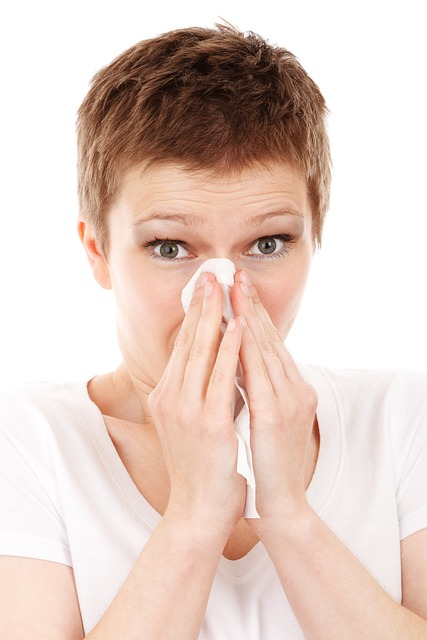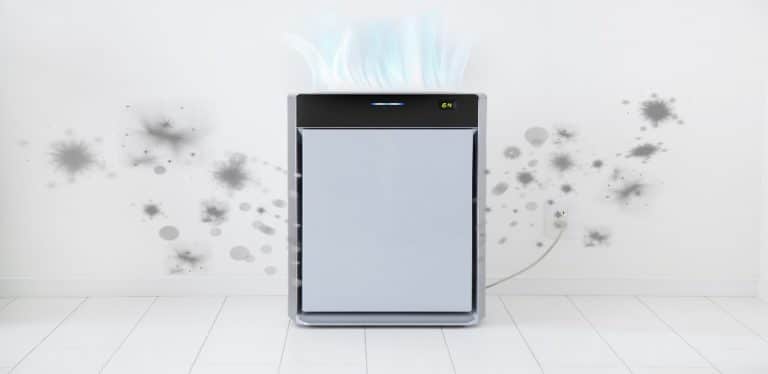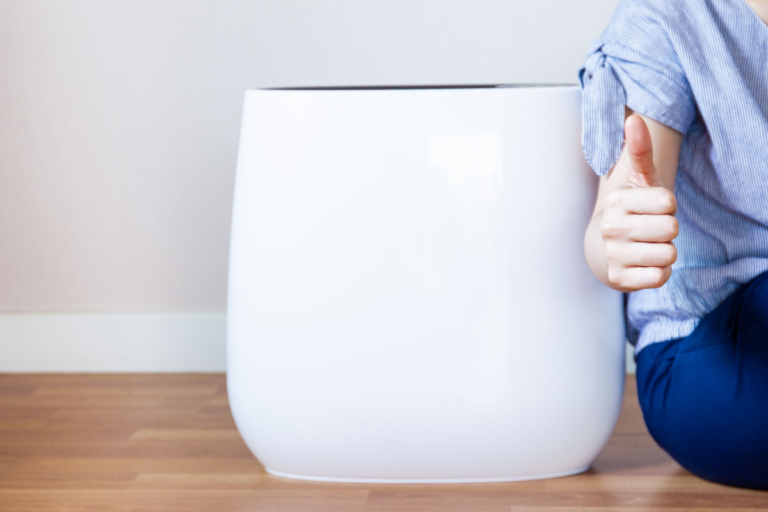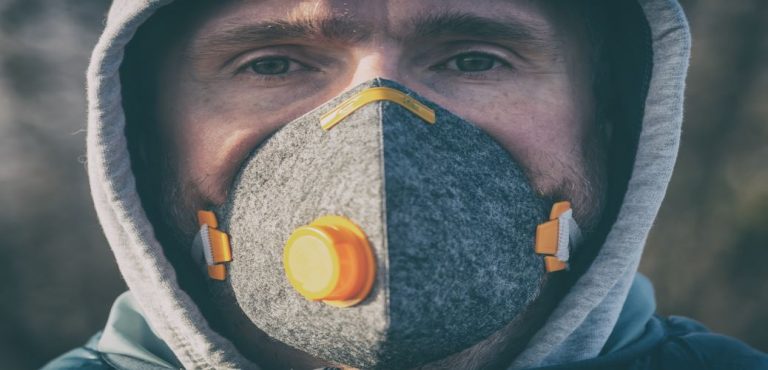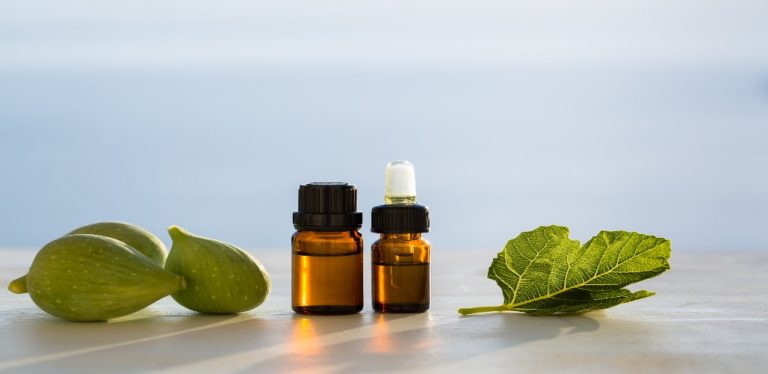22 Surprising Facts About Indoor Air Quality
You care about the food you eat, the clothes you wear, the safety of your home, but have you stopped to consider the quality of your air? Being healthy means making constant choices about what you put into your body, and what you expose yourself to, but something that is often overlooked is the air we breathe. Low indoor air quality can greatly impact you and your family. The first step towards making a change is understanding the problem.
Indoor Air Quality Facts
Here are 22 surprising facts about indoor air quality that might make you reconsider a thing or two.
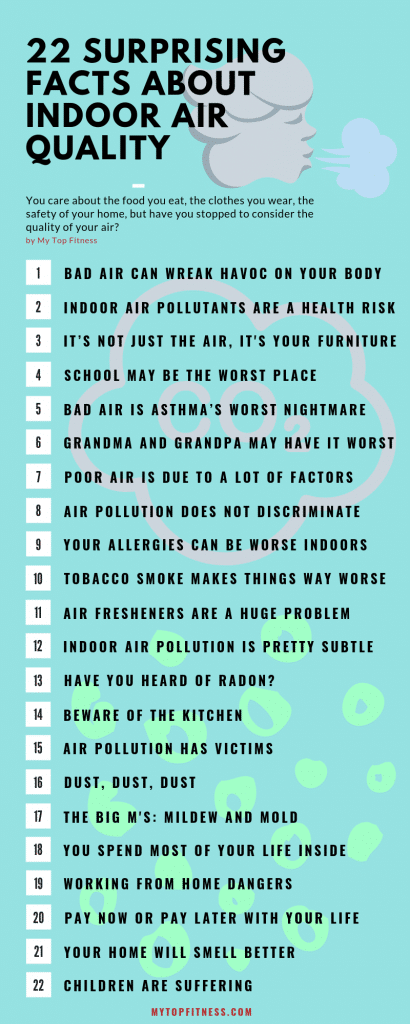
Bad Air Can Wreak Havoc on Your Body
Poor quality air hurts more than just your respiratory health. In fact, it can lead to a wide variety of physical symptoms. Things like headaches, congestion, fatigue, and nausea are some of the many things that can be traced back and attributed to your air quality. More serious conditions, such as lung cancer, depression, and even strokes have been traced back to things like radon, mold, and VOC’s found in poor quality air.
–
Indoor Air Pollutants are a Recognized Health Risk
Did you know that the United States Environmental Protection Agency ranks poor indoor air quality as one of the top five environmental health risks? Common everyday practices, such as using air fresheners or candles and cleaners containing certain chemicals can make the air that you are breathing more toxic than outdoor air affected by pollution. It is incredibly important to be mindful and wary about the products that you are bringing into your home. You will be amazed at the effects that they can have on your air quality.
–
It’s Not Just the Air, Be Mindful of Your Furniture
To keep furniture flame retardant and resistant to staining and damage, toxins are often added by the manufacturer. While these toxins have practical uses, they are also incredibly dangerous to breathe in regularly. Make sure to read where your furniture came from and what exactly it has been treated with. Pick furniture companies that treat their furniture naturally and avoid unnecessary chemicals.
–
School May Be the Worst Place
Did you know the air quality in schools can be way worse than your home, to a concerning degree? Schools have been identified as a point of concern by the EPA. This is because of the chemicals used, the many bodies packed into a confined space. Not to mention the germs and allergens that are often brought in by so many people. Make sure to ask your children’s education team about their air purification standards and what they are doing to protect your kiddos while they are at school.
–
Bad Air is Asthma’s Worst Nightmare
If you or one of your family members suffers from asthma, you know how serious this condition can be. Losing the ability to breathe effectively can be at best, scary, and at worst, detrimental to your health. Poor air quality makes it even harder for asthma victims to breathe properly. It has also been attributed as a leading cause of developing asthma, which we’ll talk about more later.
–
Grandma and Grandpa May Have the Worst Time
The elderly spend the most time indoors, meaning that they are overall the most impacted by poor air quality. While many people naturally develop health problems as they age, bad air can expedite this process and make it even harder to lead a healthy life. If you have elderly members of your family living in your home, consistent airchecks are an absolute must.
–
Poor Air is Contributed to a Variety of Factors
Poor quality air isn’t just from one thing or another. Things like mold, carbon monoxide, indoor chemicals, pet dander, dust mites, radon, and many more factors can all add up to toxic air.
–
Air Pollution Does Not Discriminate
No matter where you live and who you are, you are at risk for poor quality air in your home. Both urban and suburban homes are greatly affected by bad air.
–
Your Allergies Can Be Worse Indoors
Indoor allergies can often be worse than outdoor ones. If you suffer during allergy season, do not assume that going inside will help you escape the problem. Indoor allergens are all around and can make sneezing, itching, coughing, and problems with breathing worse than they were before. It is important to get rid of these allergens at the source.
–
Tobacco Smoke Makes Things Way, Way Worse
Indoor air pollution is a problem for many households. However, the risk of it harming your family is much, much higher when there is a smoker in the house. To effectively cut down on the risk for you and your family, make sure to educate each member about tobacco use and to cut it out of your home if all possible. Remember, only one of you may smoke but all of you will suffer.
–
Air Fresheners are a Huge Problem
While it can be tempting to whip out the air fresheners when you have an odor in your home, it’s time to reconsider before you spray. It has been found that the chemicals released from these can be absolutely lethal for your respiratory health, especially when sprayed in a compact space. Look for natural remedies to get rid of unpleasant smells and do your research before you spray your home.

–
Indoor Air Pollution is Pretty Subtle
While some smells are recognizable, the fact of the matter is that most indoor air pollutants are silent killers. You will not be able to tell just by breathing in your space whether or not your air is polluted. One of the only ways to effectively evaluate your home air quality is by professional air quality testing. If you are having doubts, it’s time to call a professional to evaluate your HVAC system.
–
Have You Heard of Radon?
Radon is a tasteless, odorless, colorless gas. Sounds harmless, right? Wrong. Radon is found in soil and can enter your home through things like cracks in the foundation, drains, windows, etc. Radon exposure is directly connected to developing respiratory cancer.
–
Beware of the Kitchen
Some of the appliances that you use every day can actually be a huge source of air pollutants. Obviously, cooking is an absolutely essential task, so you can combat this by properly ventilating your space. Make sure to be mindful of which products you use and what they are letting out into your environment.
–
Air Pollution Has Victims
According to a study from the Environmental Health Perspectives, the number of people that will lose their life due to complications from poor air quality is comparable to those who will die from car accidents. This silent killer is nothing to sleep on, and can claim the lives of you and your family if you are not careful. You would do anything to protect your loved ones, why not take the simple steps of purifying your air source.
–
Dust, Dust, Dust
According to a study done by Arch News, your home could collect about 40 pounds of dust each and every year. While this in itself is not troubling, the fact that this dust can be laced with almost 50 different chemicals should be. Make sure that you are cleaning out dusty part of your home regularly so that you can limit how much of this is being inhaled by your family.
–
Don’t Forget About the M’s: Mildew and Mold
The same study from arch news found that about 28% of American homes had an unhealthy amount of mildew and rot. These substances can greatly affect your home air quality and need to be dealt with as soon as they are detected. Many indoor allergies can be traced back to the presence of these substances in the home. While these substances are easy to overlook because they are generally common, it is important to remember that they can greatly impact your overall health and wellness.
–
You Spend Most of Your Life Inside
Whether we want to believe it or not, about 90% of our lives will be spent indoors. This means that most of the time, we are exposed to high levels of air pollutants. This is why it is absolutely crucial to not skimp on consistent air quality testing done by professionals and a properly functioning HVAC unit.
–
Working From Home Might Not Be the Luxury You Think It Is
Because your home can be so full of pollutants and bad air quality, those who work from home are much, much likelier to develop cancer. This is also something to consider when homeschooling children as well. The more time you and your family spend in your home, the more concerned you need to be about the quality of air that you breathe.
–
Pay Now or Pay Later
While the cost of getting a professional opinion on your home air quality can be deterring, it is important to factor in the cost of health care down the line if you skimp out on a good air quality system. Preventing problems such as heart attacks, stroke, and cancer is cost-effective in the long run.
–
Your Home Will Smell Better with Better Air
Although you probably do not smell it now, a build-up of pollutants can affect that scent of your home. When you take the time to purify your air, your space will feel fresher and more pleasant. This natural better smell will cut down on the candles and air scents needed to make your place smell fresh, meaning you will be using fewer chemicals. Overall, it is a win-win situation.
–
Children are Suffering
While this one may be hard to swallow, children are the real victims of the air quality crisis. There has been a rapid increase in childhood asthma and other breathing conditions in the last twenty years. According to the EPA, this can be attributed, at least partly, to the quality of air in homes.
–
What to Do About Poor Indoor Air Quality
Fortunately, there are things you can do to battle for healthy indoor air quality. These include and are not lmited to:
- HVAC inspections and regular maintenance
- Radon inspection and following recommendations to re-mediate Radon
- Mold inspection and cleaning mold out of your home and cars
- Dust and clean regularly
- Regularly change air filters and ensure you get the right air filter for your needs (ex. high allergen, mold, pet dander, etc.)
- Get outside more (especially if you work from home or homeschool)
- Detect your indoor air quality and make an action plan for cleaner air
- Use Air purifiers
There are a range of indoor air quality monitors. A few to consider are as follows:
On the air purifiers front, these range from personal air purifiers to purifiers that can cover a significant amount of square footage in your home. A few to consider are as follows:
–
Conclusion
Don’t let the air in your home be a silent killer. To protect the health and safety of each member of your family, as well as yourself, it’s time to call in the professionals to test and purify your air. This simple fix will save you a lot of time, tears, and heartache down the road by keeping your home and family as safe as possible. Don’t wait any longer, get professional help today.
[starbox]

